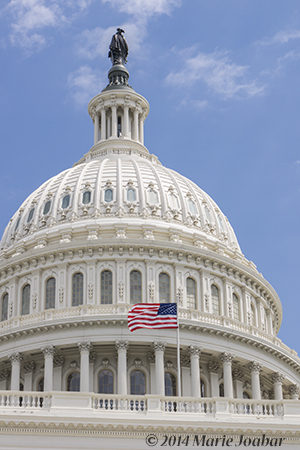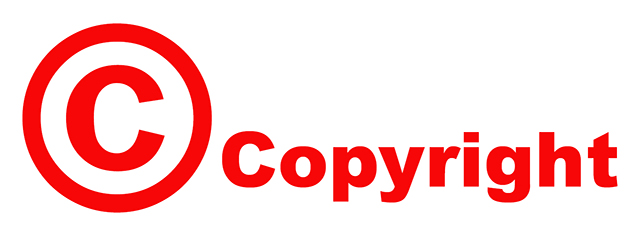Clarifying Copyright for Photographers
May 21, 2014 by Marie Joabar
 The basis for Copyright Law comes from the United States Constitution with the first Copyright Act signed into law in 1790. “The Congress shall have power… to promote the Progress of Science and useful Arts, by securing for limited times to Authors and Inventors the exclusive right to their respective Writings and Discoveries.”
The basis for Copyright Law comes from the United States Constitution with the first Copyright Act signed into law in 1790. “The Congress shall have power… to promote the Progress of Science and useful Arts, by securing for limited times to Authors and Inventors the exclusive right to their respective Writings and Discoveries.”
Since then, there have been many revisions but for photographers who are new to the Copyright world, clarifying what it entails may be helpful.
DEFINITION - Copyright is legal protection of a creator’s original work. Only the copyright holder has the right to make copies, derivative works (changes to the original), to sell or distribute copies, and display the work publicly. (In the case of “works made for hire,” the employer and not the employee is copyright holder.)
To use another’s work, permission is needed from the copyright holder and it’s illegal to violate those rights and use it without that. When in doubt, err on the side of caution and presume it is copyrighted.
WHEN DOES COPYRIGHT BEGIN AND END? - The minute you press the shutter and an image is recorded, there is copyright in your photograph. In legal terms, copyright begins with the fixation of a work. The copyright term lasts for the author’s life plus an additional 70 years after their death. For works made for hire, the duration of copyright is 95 years from publication or 120 years from creation, whichever is shorter.
PROTECTION - Copyright Protection is available for both published and unpublished works. In the current U.S. Copyright law, “publication” is defined as “the distribution of copies… of a work to the public by sale or other transfer of ownership, or by rental, lease, or lending.
Although the definition of “publication” does not specifically address online transmission, according to AMSP, “Marybeth Peters, the” former “Register of Copyrights, publicly stated on multiple occasions that her opinion, and the position of her office, is that images uploaded onto a web site in an area that is available to the public for access, constitutes publication of the work. Assuming that this area of your web site isn’t password-protected or otherwise restricted, it is probably safe to take the position that those photographs are published.”
Publication is not required for copyright protection nor is registration of the work with the Copyright Office. However, there are definite advantages to registering your work, the most important is, to be eligible for the full benefits of copyright law, you must register before an infringement (or within 3 months of first publication).
REGISTERING YOUR WORK - This has become easier over the years and today, the copyright office encourages us to register online through electronic Copyright Office (eCO) which offers reduced pricing and faster processing times than filing paper forms.
Either way, complete the form, pay the filing fee and submit the work you’re registering. If online, simply upload your work. If mailing, submit photos via mail with a DVD or CD.
There is currently no limit to the number of unpublished work (images) that you can register at one time. However, a reliable source says this may change in the future.
Published and unpublished works need to be filed separately and it’s recommended that your photographs are registered BEFORE they are published.
To access eCO, visit www.copyright.gov/eco/
To access fill-in paper Form VA (visual arts works), visit www.copyright.gov/forms/formva.pdf
COPYRIGHT NOTICE - The use of a “copyright notice” is no longer required (for work created since 3/1/89) but is often beneficial as it alerts others that the work is protected, it identifies the copyright holder and it shows the year the copyright began. If you are going to use notice, it should contain those three elements:
1. The word “Copyright” or the © symbol (the letter C in a circle)
2. The year of first publication
3. The name of the copyright holder. For example; © 2014 Marie Joabar
 The symbol can be made by typing “Option G” on a Mac and on a PC, by holding down the ‘Alt’ key and typing 0169.
The symbol can be made by typing “Option G” on a Mac and on a PC, by holding down the ‘Alt’ key and typing 0169.
FACTOIDS
Derivative Work refers to a work that is based on, or modifies, one or more preexisting works. A copyright owner has the exclusive right to prepare or authorize the preparation of a derivative work based on the copyrighted work.
License is a contractual agreement from a copyright owner or the owner’s authorized agent allowing another party to exercise one or more of the exclusive rights provided the copyright owner under the Copyright Law. Licenses usually involve the payment of a fee or royalty.
Public Domain refers to works that are not protected by copyright and are publicly available. They may be used by anyone, anywhere, anytime without permission, license or royalty payment.
Note: A work is not in the public domain simply because it does not have a copyright notice. The user is responsible for determining whether a work is in the public domain.
Older works published before 1923 are now in the public domain. Some newer works may have fallen into the public domain through lack of proper registration procedures. For a fee, the Copyright Office will do a search for you, to determine the copyright status of a particular work.
Fair Use - Images can be copied without the copyright holder’s permission for “purposes such as parody, criticism, comment, news reporting, education (including the distribution of multiple copies for classroom use), scholarship, or research. ” From ASMP website.
Copyright for Buildings - “As long as the building is in a public place, or visible — and photographable — from a public place, there is no infringement of the building’s copyright owner’s rights. This rule includes private as well as public buildings.” From ASMP website.
CONTACT THE COPYRIGHT OFFICE:
By Internet
- Circulars, announcements, regulations, all application forms, and other materials are available from the Copyright Office website at www.copyright.gov.
By Telephone - The Copyright Public Information number is (202) 707-3000 or 1-877-476-0778 (toll free) 8:30 am to 5:00 pm, eastern time, Monday through Friday, except federal holidays. Recorded information is available 24 hours a day. To request paper application forms or circulars, call the Forms and Publications Hotline at (202) 707-9100 and leave a recorded message.
In Person - The Copyright Public Information Office is open to the public 8:30 am to 5:00 pm Monday through Friday, eastern time, except federal holidays. The office is located in the Library of Congress, James Madison Memorial Building, 101 Independence Avenue SE, Washington, DC, near the Capitol South Metro stop.
RESOURCES
More information about Copyright from ASMP can be found here. http://asmp.org/content/registration-counts#.U3tAECQQzdS
